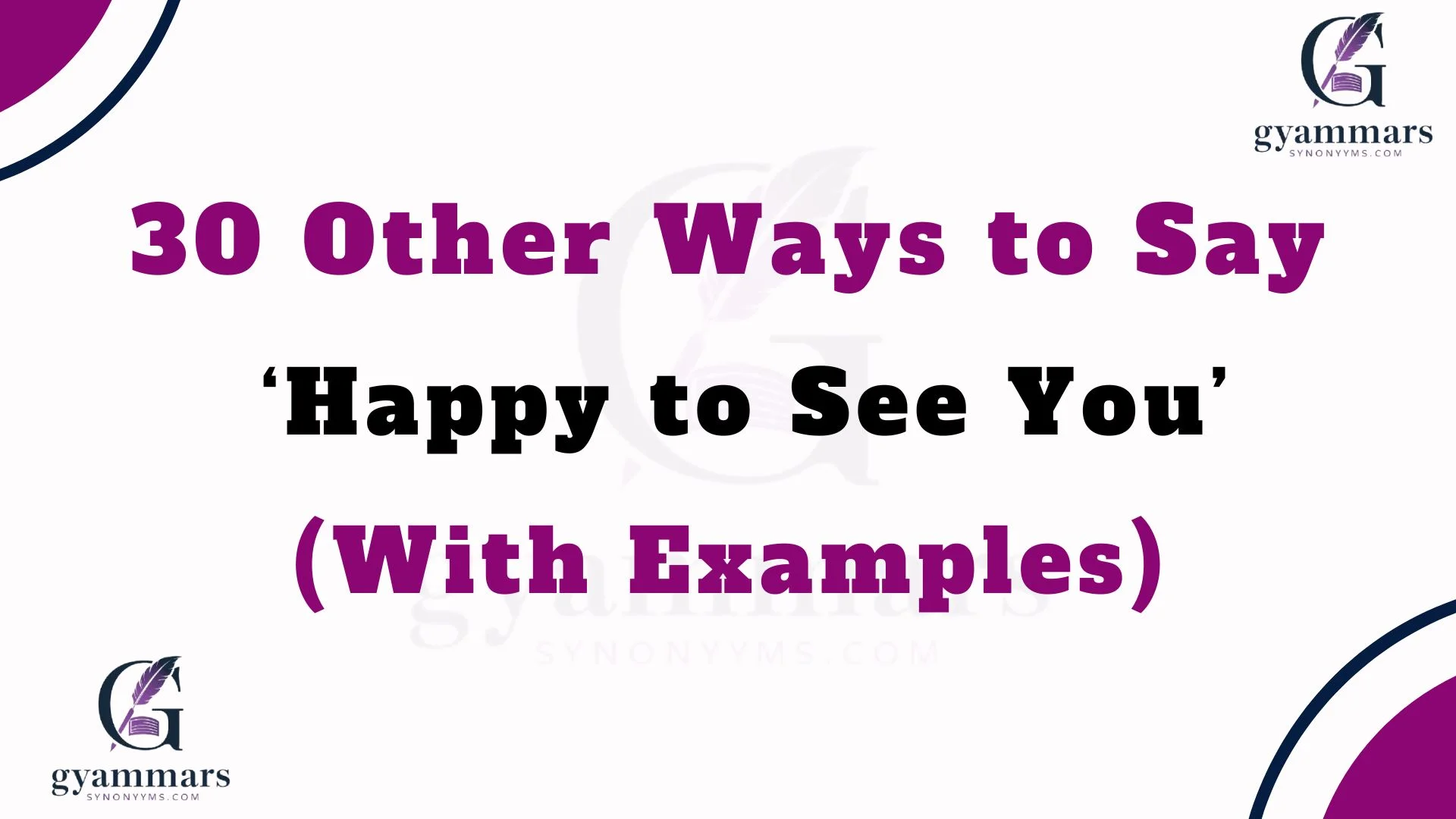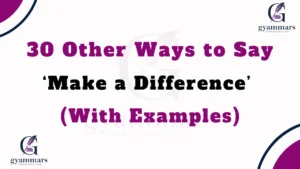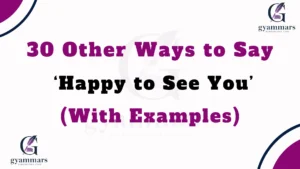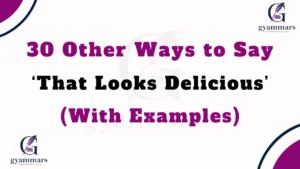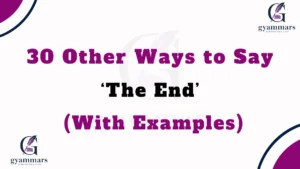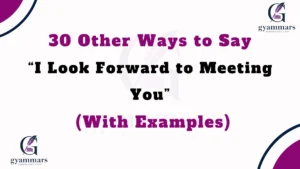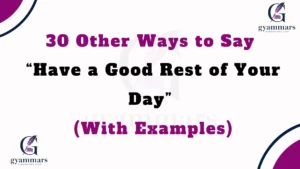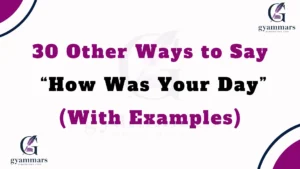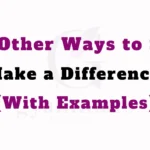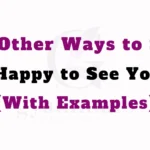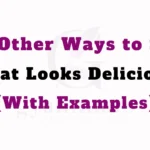Sometimes, the right words make all the difference when you want to express warmth, care, and genuine happiness toward someone. Saying “Happy to see you” is simple and kind, but there are many other ways to show that same joy with a bit more personal touch. Using alternative phrases can make your message feel unique, heartfelt, and memorable—whether in personal conversations, professional settings, or casual catch-ups.
Below, you’ll find 30 thoughtful alternatives to “Happy to see you,” each with definitions, detailed explanations, scenarios, examples, best uses, tones, and extra notes.
What Does “Happy to See You” Mean?
The phrase “Happy to see you” is a way of expressing warmth, affection, or appreciation when encountering someone. It communicates that their presence brings you joy and comfort.
Is It Professional/Polite to Say “Happy to See You”?
Yes. It is both professional and polite. However, in professional contexts, you may want to use slightly more formal alternatives like “It’s a pleasure to see you” or “Glad we could meet.”
Pros or Cons of Saying “Happy to See You”
Pros:
- Simple, warm, and universally understood
- Works in both personal and casual professional settings
- Shows genuine kindness and connection
Cons:
- Might sound repetitive if overused
- Less formal compared to polished professional alternatives
- May not fully capture deeper emotions or enthusiasm
Synonyms For ‘Happy to See You’
- Glad to see you
- It’s a pleasure to see you
- Great to see you
- Nice to see you
- Delighted to see you
- Thrilled to see you
- So good to see you
- Always a joy to see you
- Wonderful to see you
- I’m so glad we met today
- Good seeing you
- Lovely to see you
- Heartwarming to see you
- Always great running into you
- Overjoyed to see you
- So glad you’re here
- Nice catching up with you
- Happy to run into you
- So glad to bump into you
- It’s been too long
- You made my day
- So nice running into you
- I’ve missed seeing you
- What a treat to see you
- I’m really glad you came
- So wonderful catching you here
- You brighten my day
- Glad we could connect
- So glad to be with you
- Truly happy to see you
1. Glad to see you
Definition: Expresses genuine gladness at someone’s presence.
Explanation: A slightly lighter version of “happy,” making it friendly yet approachable.
Example: “I’m so glad to see you after such a long time!”
Best Use: Casual conversations with friends, colleagues, or acquaintances.
Tone: Warm, welcoming, and easygoing.
Notes: Works well in both personal and semi-formal settings.
2. It’s a pleasure to see you
Definition: A more formal and polished way to express joy in seeing someone.
Explanation: Adds a professional and respectful nuance.
Example: “It’s always a pleasure to see you at these meetings.”
Best Use: Workplace, networking events, or client meetings.
Tone: Polite, respectful, and professional.
Notes: Strong choice when maintaining formality.
3. Great to see you
Definition: Enthusiastic way to show happiness about someone’s presence.
Explanation: Stronger than “glad,” and feels more energetic.
Example: “Great to see you at the party last night!”
Best Use: Friendly encounters, social gatherings.
Tone: Energetic, upbeat.
Notes: Very versatile for casual situations.
4. Nice to see you
Definition: A neutral, polite phrase to acknowledge someone warmly.
Explanation: Works when you want to be kind but not overly expressive.
Example: “It’s really nice to see you again.”
Best Use: Both professional and casual greetings.
Tone: Neutral, polite.
Notes: A safe go-to phrase.
5. Delighted to see you
Definition: Expresses deeper joy, stronger than “happy.”
Explanation: Conveys genuine excitement.
Example: “I’m delighted to see you here!”
Best Use: Formal yet heartfelt situations.
Tone: Cheerful, enthusiastic.
Notes: Adds extra warmth in formal exchanges.
6. Thrilled to see you
Definition: A more animated expression of happiness.
Explanation: Highlights a sense of excitement.
Example: “I’m thrilled to see you after all these years!”
Best Use: Long reunions, special moments.
Tone: Excited, heartfelt.
Notes: Better suited for personal than professional.
7. So good to see you
Definition: Simple, heartfelt acknowledgment of joy.
Explanation: A middle ground between formal and casual.
Example: “It’s so good to see you here today.”
Best Use: Any context—professional, casual, or personal.
Tone: Warm, genuine.
Notes: Extremely versatile.
8. Always a joy to see you
Definition: Expresses consistent joy in someone’s presence.
Explanation: Shows ongoing affection or appreciation.
Example: “It’s always a joy to see you.”
Best Use: Close friendships, family.
Tone: Loving, caring.
Notes: Works beautifully in personal relationships.
9. Wonderful to see you
Definition: Warm and appreciative acknowledgment.
Explanation: Stronger than “nice” but less formal than “pleasure.”
Example: “It’s wonderful to see you again.”
Best Use: Both casual and semi-professional.
Tone: Warm, polished.
Notes: Adds a touch of elegance.
10. I’m so glad we met today
Definition: Gratitude for meeting someone.
Explanation: Goes beyond joy, adding appreciation.
Example: “I’m so glad we met today—it made my day better.”
Best Use: Professional meetings, chance encounters.
Tone: Appreciative, thoughtful.
Notes: Works when you want to highlight meaning.
11. Good seeing you
Definition: A shorter, casual variation.
Explanation: Informal yet friendly.
Example: “Good seeing you at lunch today.”
Best Use: Casual interactions.
Tone: Laid-back.
Notes: Not ideal for formal settings.
12. Lovely to see you
Definition: Warm and affectionate acknowledgment.
Explanation: Adds a tender, kind tone.
Example: “It’s lovely to see you here.”
Best Use: Friends, family, close colleagues.
Tone: Gentle, affectionate.
Notes: Best when warmth is intended.
13. Heartwarming to see you
Definition: Emphasizes emotional comfort.
Explanation: Suggests their presence brings genuine happiness.
Example: “It’s heartwarming to see you again.”
Best Use: Personal relationships, reunions.
Tone: Emotional, caring.
Notes: Adds depth to greetings.
14. Always great running into you
Definition: Friendly acknowledgment of a chance meeting.
Explanation: Expresses delight at unexpected encounters.
Example: “Always great running into you at the café.”
Best Use: Casual, spontaneous meetings.
Tone: Friendly, approachable.
Notes: Informal but warm.
15. Overjoyed to see you
Definition: Expresses intense happiness.
Explanation: Stronger than “delighted.”
Example: “I’m overjoyed to see you safe and sound.”
Best Use: Special or emotional reunions.
Tone: Deeply heartfelt.
Notes: Rare, but powerful.
16. So glad you’re here
Definition: Expresses gratitude for someone’s presence.
Explanation: More situational—fits events or gatherings.
Example: “I’m so glad you’re here tonight.”
Best Use: Events, group settings.
Tone: Appreciative, inclusive.
Notes: Great for hosts.
17. Nice catching up with you
Definition: Joy in reconnecting.
Explanation: Best for after a chat or reunion.
Example: “It was nice catching up with you today.”
Best Use: After conversations or meetings.
Tone: Friendly, casual.
Notes: Works well as parting words.
18. Happy to run into you
Definition: Joy in unexpected meetings.
Explanation: A casual, spontaneous phrase.
Example: “Happy to run into you downtown!”
Best Use: Casual settings.
Tone: Light, informal.
Notes: Not for formal situations.
Read More : 30 Other Ways to Say ‘That Looks Delicious’ (With Examples)
19. So glad to bump into you
Definition: Similar to “run into,” informal but kind.
Explanation: Conveys delight in coincidence.
Example: “So glad to bump into you today.”
Best Use: Casual encounters.
Tone: Cheerful, relaxed.
Notes: Informal language.
20. It’s been too long
Definition: Expresses joy mixed with recognition of time apart.
Explanation: Highlights reunion after absence.
Example: “It’s been too long! So happy to see you again.”
Best Use: Reunions with friends, family.
Tone: Warm, nostalgic.
Notes: Great for heartfelt meetings.
21. You made my day
Definition: Someone’s presence brought joy.
Explanation: Goes beyond “happy,” adds emotional depth.
Example: “Seeing you today really made my day.”
Best Use: Close personal relationships.
Tone: Grateful, affectionate.
Notes: Heart-touching phrase.
22. So nice running into you
Definition: Casual joy for unexpected meetings.
Explanation: Friendly and approachable.
Example: “So nice running into you at the mall.”
Best Use: Casual meetings.
Tone: Polite, warm.
Notes: Neutral but positive.
23. I’ve missed seeing you
Definition: Adds emotional depth to a reunion.
Explanation: Conveys absence and joy at return.
Example: “I’ve missed seeing you—it’s so good to reconnect.”
Best Use: Friends, family, close ties.
Tone: Emotional, affectionate.
Notes: Not for formal contexts.
24. What a treat to see you
Definition: Expresses delight, as if the encounter is special.
Explanation: Frames meeting as a happy surprise.
Example: “What a treat to see you today!”
Best Use: Friendly or casual encounters.
Tone: Playful, cheerful.
Notes: Lighthearted and fun.
25. I’m really glad you came
Definition: Appreciates someone’s presence at an event.
Explanation: Goes beyond joy to gratitude.
Example: “I’m really glad you came tonight.”
Best Use: Events, gatherings.
Tone: Warm, appreciative.
Notes: Great for hosts.
26. So wonderful catching you here
Definition: Joyful acknowledgment of seeing someone.
Explanation: Fits surprise or casual meetings.
Example: “So wonderful catching you here today.”
Best Use: Informal yet warm greetings.
Tone: Polite, cheerful.
Notes: Slightly casual.
27. You brighten my day
Definition: Someone’s presence adds light or joy.
Explanation: Emotional and affectionate phrase.
Example: “You always brighten my day when I see you.”
Best Use: Friends, partners, family.
Tone: Heartfelt, caring.
Notes: Deeply personal.
28. Glad we could connect
Definition: Expresses happiness about interaction.
Explanation: Ideal for professional or casual conversations.
Example: “I’m glad we could connect at this event.”
Best Use: Networking, workplace.
Tone: Professional, friendly.
Notes: Formal but warm.
29. So glad to be with you
Definition: Highlights togetherness and joy.
Explanation: Beyond just “seeing,” it emphasizes presence.
Example: “I’m so glad to be with you today.”
Best Use: Close relationships, family, supportive settings.
Tone: Caring, affectionate.
Notes: Very heartfelt.
30. Truly happy to see you
Definition: Reinforces sincerity.
Explanation: Slightly more meaningful than “happy.”
Example: “I’m truly happy to see you again.”
Best Use: Personal or professional.
Tone: Sincere, respectful.
Notes: Simple but powerful.
Conclusion
Finding different ways to say “Happy to see you” allows you to connect more meaningfully with others. Whether you want to sound professional, casual, affectionate, or deeply heartfelt, there’s an alternative that fits the moment perfectly. The words you choose can make your interactions feel genuine, warm, and unforgettable.
FAQs:
1. What is another word for “Happy to see you”?
Alternatives include “Glad to see you,” “Great to see you,” or “It’s a pleasure to see you.”
2. Is “Happy to see you” formal?
It’s polite and warm but not highly formal. For formality, say “It’s a pleasure to see you.”
3. Can I use “Happy to see you” in emails?
Yes, especially in casual or semi-professional emails. For formal emails, use “It’s a pleasure to connect with you.”
4. What’s the most emotional way to say it?
Phrases like “I’ve missed seeing you” or “You brighten my day” carry more heartfelt emotion.
5. Which alternative works best for professional settings?
Phrases such as “It’s a pleasure to see you” or “Glad we could connect” work best professionally.

“Emma Rose at Grammar Synonyms is your go-to expert for everything related to language and expression. Whether you’re refining your grammar, searching for the perfect synonym, or looking for creative ways to improve your writing, Emma Rose provides the tools and inspiration you need. With a wide range of resources designed to elevate your communication, Grammar Synonyms helps you find just the right words to make every sentence shine.
